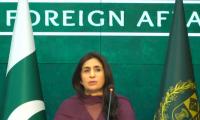Karachi
Dr Qamar-uz-Zaman Chaudhry, the lead author of Pakistan's National Climate Change Policy, said on Wednesday that the Paris climate accord was a historic agreement and definitely a turning point for world transformation even though it might not be a perfect one.
“We now have the potential to change how we do business, as all future investment will go in low-carbon emission technologies,” he added.
Following are key points of the Paris accord:
Long-term goal
The long-term objective of the agreement is to make sure global warming stays "well below" 2 degrees Celsius (3.6 degrees Fahrenheit) and to "pursue efforts" to limit the temperature rise to 1.5 degrees Celsius (2.7 degrees Fahrenheit). Temperatures have already increased by about 1 degree Celsius (1.8 degrees Fahrenheit) since pre-industrial times. To achieve that goal, governments pledged to stop the rise in heat-trapping greenhouse gas emissions "as soon as possible." By some point after 2050, the agreement says, man-made emissions should be reduced to a level that forests and oceans can absorb.
Emissions targets
In order to reach the long-term goal, countries agreed to set national targets for reducing greenhouse gas emissions every five years. More than 180 countries have already submitted targets for the first cycle beginning in 2020. Only developed countries are expected to slash their emissions in absolute terms; developing nations are "encouraged" to do so as their capabilities evolve over time. Until then, they are expected only to rein in the growth of emissions as their economies develop.
Reviewing targets
The initial targets would not be enough to put the world on a path to meet the long-term temperature goal. So the agreement asks governments to review their targets in the next four years and see if they can "update" them. That doesn't require governments to deepen their cuts. But the hope is that it will be possible for them to do so if renewable energy sources become more affordable and effective.
Transparency
There is no penalty for countries that miss their emissions targets. But the agreement has transparency rules to help encourage countries to actually do what they say they will do. That was one of the most difficult pieces to agree on, with China asking for softer requirements for developing countries. The agreement says all countries must report on their emissions and their efforts the reduce them. But it allows for some "flexibility" for developing countries that "need it."
Money
The agreement says wealthy countries should continue to offer financial support to help poor countries reduce their emissions and adapt to climate change. It also encourages other countries to pitch in on a voluntary basis. That paves the way for emerging economies such as China to contribute, even though it doesn't require them to do so. Actual dollar amounts were kept out of the agreement itself, but wealthy nations had previously pledged to provide $100 billion in climate finance by 2020.
Loss and damage
In a victory for small island nations threatened by rising seas, the agreement includes a section recognizing "loss and damage" associated with climate-related disasters.
The U.S. long objected to addressing the issue in the agreement, worried that it would lead to claims of compensation for damage caused by extreme weather events. In the end, the issue was included, but a footnote specifically stated that loss and damage does not involve liability or compensation.
Dr Qamar said to goal to limit the temperature rise to 1.5 degrees Celsius was too ambitious and humanity could be better served by focusing on the mechanisms to ensure that global warming stays 2 degrees Celsius
“Limiting global warming to 2 degrees Celsius means emissions will have to fall by 40 to 70 percent by the mid-century, but any clear deadlines or specific targets are generally absent in the accord and largely depend on nationally determined emission reduction pledges,” he added.
Dr Qamar noted that another worrying aspect of the agreement was that it allowed several years to pass until 2020, before taking any serious efforts to reduce emissions.
He said Pakistan was among the 10 most climate change-vulnerable countries.
“But we can achieve many opportunities from this accord if we act wisely and proactively in the new emerging global climate regime, which will encompass businesses, industries, and social and political spheres of our lives.”
Weak deal
India’s top independent think-tank, the Centre for Science and Environment (CSE), termed the Paris accord a weak deal.
In a statement, it said the agreement in many ways was the lowest denominator
It noted that developed countries had not committed any significant finance or emission cuts before 2020
The biggest winners are the developed countries as their historical responsibility has finally been erased.
There are no major short-term wins or losses for India as it had failed to achieve a fair share of carbon space.
“The phrase ‘historical responsibility’ has been erased from the agreement and this weakens the obligations of developed countries to take actions due to their past emissions. Without historical responsibility, equity will now be interpreted only through the words ‘respective capabilities and national circumstances’ further removing differentiation between the climate actions of developed and developing countries,” said Chandra Bhushan, the deputy director general of the CSE.
“To erase any notion of historical responsibility, the developed countries have gone to the extent of mentioning in the text that the damage due to climate change does not involve or provide a basis for any liability or compensation.”
Analysis of adopted text
The differentiation between developed and developing countries is maintained in the text in some parts, particularly on finance, but it must be noted that this is weak differentiation based on capabilities and not on historic responsibilities. Also, no financial target has been mentioned in the agreement.
The words ‘equity’ and ‘common but differentiated responsibilities’ have been mentioned in many places, but are negated by the fact that the nationally determined contributions of countries are not legally binding and everyone has to take on mitigation commitments. The text does not mention the support for loss and damage, but clearly specifies that this will not be considered as liability or compensation.
This further weakens the obligations of developed countries and erases responsibilities of dealing with the consequences of their past emissions.
References to carbon budgets is gone and so developed countries can continue to disproportionally appropriate carbon space in the future as they have done in the past.
A fair distribution of the remaining carbon space based on historical responsibilities could have avoided this inequity.
Developed countries have been given carbon market through which they can offset their emissions, so they will do even less domestically than what they have promised in their nationally determined contributions.
The Paris pact has agreed on a voluntary carbon market to buy and sell carbon credits. This means that the developed countries are likely to do even low emission cuts domestically as they will buy credits from the developing countries.
An aerial view of Karachi city. — AFP/FileCelebrating ShakespeareThe National Academy of Performing Arts is...
This representational image shows a woman touching a dead body's legs. — APP/FileThe woman killed on Wednesday in...
The University of Karachi entrance gate. — APP/FileThe role of educated mothers is crucial for the development of...
Secretary Information Department Nadeem-ur-Rehman Memon. — Facebook/Umerkot - Gateway to TharSecretary Information...
Commissioner Karachi Syed Hasan Naqvi chairs a meeting to assess the preparations for the upcoming 29th International...
Sindh’s chief secretary Syed Asif Hyder Shah chairs a meeting with the National Highway Authority on April 18,...







